You’ll find West Virginia’s mountainous terrain offers unique growing conditions that most gardeners never experience elsewhere. The state’s elevation changes, from 240 feet to over 4,863 feet, create distinct microclimates where specific native plants absolutely flourish. Your garden’s success depends entirely on understanding which elevations support wildflowers versus towering canopy species, and there’s one critical factor that determines everything.
Contents
- 1 West Virginia’s Mountainous Climate Overview
- 2 Wildflowers for Mountain Gardens
- 3 Essential Native Canopy Trees
- 4 Native Understory Shrub Options
- 5 Selecting the Right Native Plants for Your Garden
- 6 Frequently Asked Questions
- 6.1 How Do I Propagate Native Mountain Plants From Seeds or Cuttings?
- 6.2 What Native Plants Attract Hummingbirds and Butterflies to Mountain Gardens?
- 6.3 Which Mountain Natives Are Deer Resistant and Won’t Be Eaten?
- 6.4 How Often Should I Water Newly Planted Native Mountain Species?
- 6.5 What’s the Best Time of Year to Transplant Established Native Plants?
West Virginia’s Mountainous Climate Overview
When you explore West Virginia’s mountainous terrain, you’ll discover a climate shaped by dramatic elevation changes and rugged topography that creates some of the most diverse growing conditions east of the Mississippi River. These elevation effects produce temperatures ranging from 56°F in southern valleys to 48°F in high peaks, while climate impacts include snowfall varying from 20 inches to over 125 inches annually.
You’ll find three distinct regions—Appalachian Plateau, Valley and Ridge, and Allegheny Mountains—each creating unique microclimates. The mountainous areas receive 60+ inches of precipitation yearly, supporting lush plant communities that change dramatically within short distances. This humid continental climate with marine modification in the eastern panhandle creates ideal conditions for native mountain flora to flourish throughout the state’s diverse elevational zones.
Wildflowers for Mountain Gardens
Mountain wildflowers offer diverse options for every garden situation, from showy drought-tolerant specimens to early woodland bloomers, pollinator magnets, and spreading groundcovers for challenging slopes. These native perennials are well-adapted to West Virginia’s mountain conditions and include both pure species and naturally-occurring hybrids that have evolved in the region.
Trout Lily
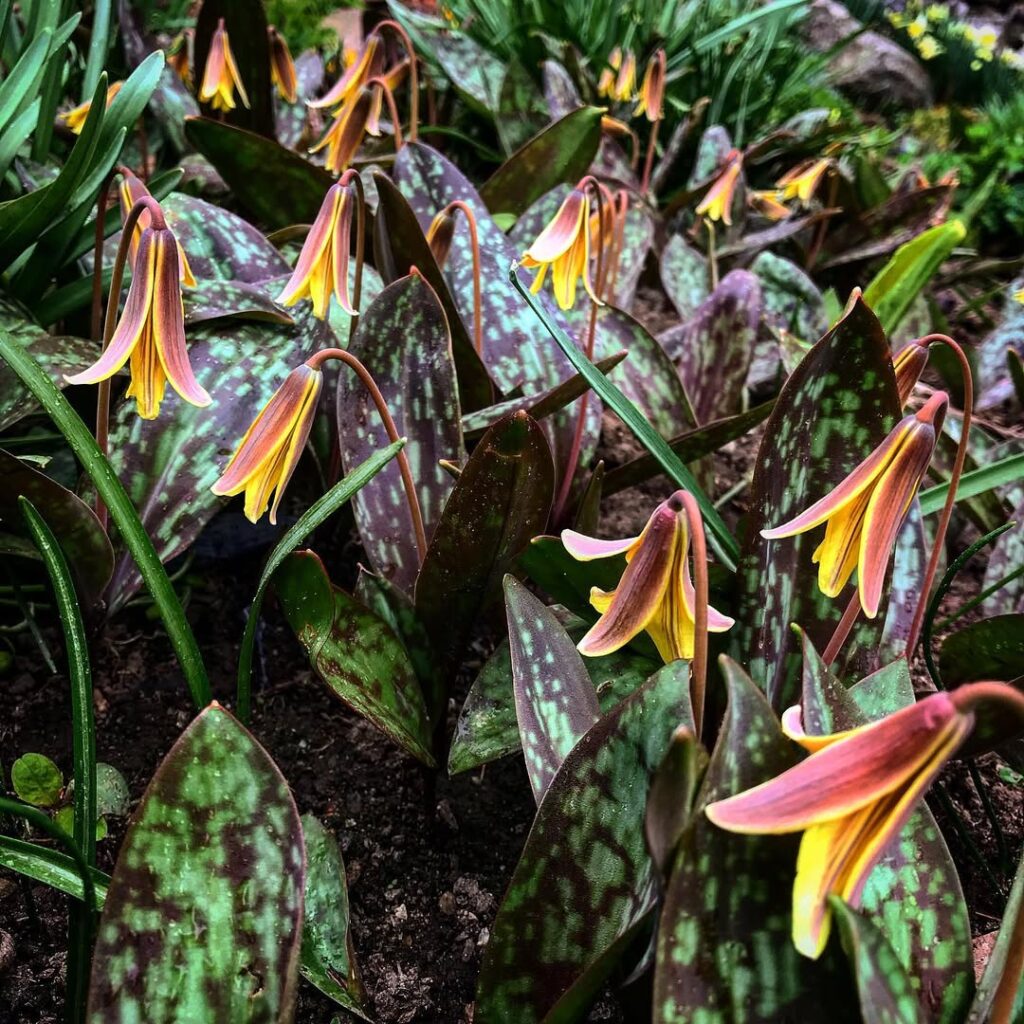
Trout Lily is a delicate spring ephemeral that emerges in early spring before the forest canopy leafs out. This perennial wildflower grows from a corm and produces two distinctive mottled leaves with a single nodding yellow flower. Mature colonies can persist for centuries, spreading slowly through underground runners.
As a true woodland native, Trout Lily thrives in the understory of deciduous forests where it takes advantage of early spring sunlight. Its brief above-ground presence lasts only about one month, making it a fleeting but treasured addition to mountain gardens. The plant provides essential early-season nectar for pollinators, including specialist bees that depend exclusively on its pollen. After establishment, these resilient plants require only rain for sustenance and thrive with minimal care.
- Hardiness: Cold hardy, tolerates cool spring temperatures
- Light: Partial shade to full shade
- Water: Consistent moisture, well-draining but not waterlogged
- Soil: Moist, humus-rich, organic woodland soil
- Fertilizer: None required; benefits from leaf litter mulch
- Pest/Disease Resistance: Generally pest and disease free
- Growth Rate: Slow to establish, colonies expand gradually over decades
Wild Bleeding Heart

Wild Bleeding Heart (Dicentra eximia) is a delicate native wildflower perfectly suited for West Virginia’s mountainous woodland gardens. This charming perennial produces distinctive heart-shaped pink flowers on arching stems above deeply cut, fern-like foliage from late spring through summer. Forming neat mounding clumps 12-18 inches tall, it thrives in the shaded conditions where many other wildflowers struggle.
As a low-maintenance native, Wild Bleeding Heart supports local pollinators while remaining well-behaved in garden settings. Its extended bloom period and deer resistance make it an excellent choice for naturalizing along woodland edges or incorporating into shaded borders, providing continuous interest throughout the growing season. The plant can be easily propagated by division in late fall or early spring for expanding plantings.
- Hardiness: USDA Zones 3-9
- Light: Partial to full shade; tolerates deep shade
- Water: Consistently moist; tolerates wet conditions but not prolonged drought
- Soil: Rich, well-drained, moist soils
- Fertilizer: Low requirements; thrives in low-input environments
- Pest/Disease Resistance: Excellent; minimal insect or disease problems, deer and rabbit resistant
- Growth Rate: Moderate; forms clumps 18-24 inches wide at maturity
Wild Ginger
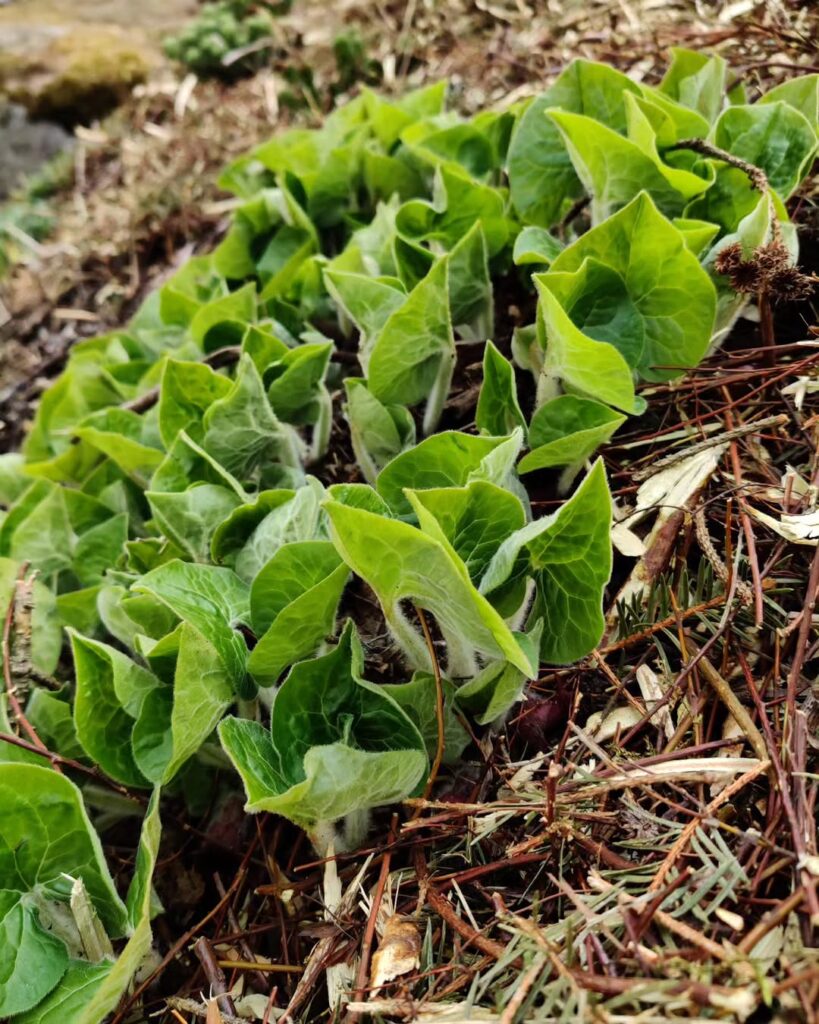
Wild ginger is a low-growing native perennial that forms attractive colonies in woodland settings. This charming groundcover produces soft, heart-shaped leaves with a velvety texture and distinctive bell-shaped flowers that hide beneath the foliage. Despite its common name, it’s not related to culinary ginger but does emit a similar aromatic fragrance when crushed.
The plant spreads slowly through branching rhizomes to create natural carpets in forest understories. Its unique flowers are positioned close to the ground to attract small flies for pollination, while ants help disperse the seeds. Wild ginger provides excellent erosion control and creates habitat for woodland creatures. The flowers consist of three fused sepals and completely lack petals, giving them their distinctive jug-like appearance.
- Hardiness: Zones 4-8
- Light: Full to partial shade
- Water: Moderate to moist, consistent moisture preferred
- Soil: Rich, well-draining, organic woodland soil
- Fertilizer: Light application of compost annually
- Pest/Disease Resistance: Generally pest and disease free
- Growth Rate: Slow to establish, moderate spread once established
Wild Columbine
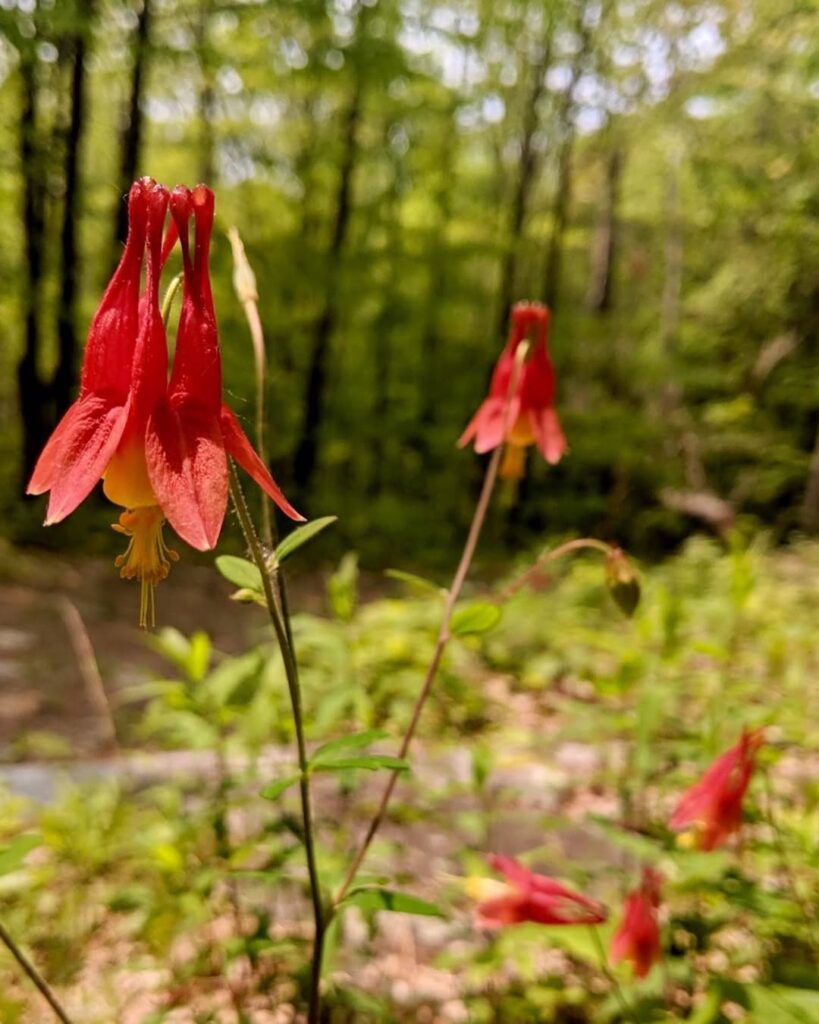
Wild columbine (Aquilegia canadensis) is a charming native wildflower that brings vibrant red and yellow blooms to West Virginia’s mountain gardens. This semi-evergreen perennial grows up to 3 feet tall with distinctive nodding flowers featuring upward-pointing spurs. The showy 2-inch blooms appear from spring through summer, attracting hummingbirds and butterflies to woodland settings.
With its blue-green foliage and clumping habit, wild columbine thrives in the partially shaded conditions typical of mountain forests. This adaptable native produces seed pods that split to release shiny black seeds, allowing for natural propagation in suitable garden conditions. Wild columbine develops a tap root system that helps it access deep soil moisture and nutrients in woodland environments.
- Hardiness: USDA zones 3a-8b
- Light: Partial shade; tolerates more sun with adequate moisture
- Water: Medium moisture requirements; prefers consistently moist but well-draining soil
- Soil: Organically rich, neutral pH (6.0-8.0); adapts to clay, loam, or sand textures
- Fertilizer: Low requirements; avoid excessively rich soils
- Pest/Disease Resistance: Generally resistant with good cultural practices
- Growth Rate: Medium growth rate with medium maintenance needs
Wild Bergamot

Wild bergamot is a native North American perennial in the mint family, prized for its aromatic foliage and showy flower clusters. This clump-forming wildflower produces tubular blooms in shades of lavender, pink, or white from June through September, attracting bees, butterflies, and hummingbirds to mountain gardens. Growing 2-5 feet tall with gray-green, lance-shaped leaves, wild bergamot spreads by rhizomes to form attractive stands.
Historically valued for medicinal teas and essential oils, wild bergamot thrives in West Virginia’s mountainous terrain. Its tolerance for diverse soil conditions, including black walnut sites, makes it versatile for native plantings. The fragrant flowers serve as excellent honey plants while providing essential habitat for local pollinators and insects. Seeds ripen approximately 2 months after the blooming period ends, making fall collection optimal for propagation.
- Hardiness: Native to mountainous regions of West Virginia; cold hardy perennial
- Light: Full sun preferred; tolerates partial shade
- Water: Dry to moderately moist conditions; drought tolerant once established
- Soil: Adaptable to both rich and limy soils; thrives in well-draining sites
- Fertilizer: Low maintenance; typically does not require supplemental feeding
- Pest/Disease Resistance: Generally resistant to powdery mildew; occasional rust issues; avoid overcrowding
- Growth Rate: Moderate; spreads by rhizomes to form clumps and larger stands
Essential Native Canopy Trees
West Virginia’s mountain forests are dominated by diverse native canopy trees that provide essential wildlife habitat, stabilize ecosystems, and create the structural foundation for complex forest communities. These native trees require less attention than non-natives and hybrids while coping better with local environmental conditions.
American Basswood

American Basswood stands as one of West Virginia’s most valuable native canopy trees, reaching impressive heights of 60-120 feet with broad, dense crowns that provide exceptional shade. Known as the “bee-tree” for its highly fragrant, nectar-rich flowers that bloom in late spring, this deciduous giant supports both wildlife and pollinators while serving as a dominant species in rich hardwood forests.
The tree features large, heart-shaped leaves with coarsely toothed margins and distinctive nut-like fruits attached to leafy bracts for wind dispersal. Its soft, light wood has been prized for furniture and crafts, while Indigenous peoples historically used its inner bark fibers for rope-making. American Basswood’s vigorous sprouting habit helps it recover from disturbances and contributes to forest regeneration.
These remarkable trees can live for approximately 200 years, making them long-term investments in landscape sustainability and forest ecosystem health. • Hardiness: USDA zones 3-8, well-adapted to Appalachian conditions
- Light: Full sun to partial shade, tolerates understory conditions
- Water: Prefers consistently moist, well-drained soils
- Soil: Thrives in rich, fertile soils but adaptable to various site conditions
- Fertilizer: Generally not required in native forest settings
- Pest/Disease Resistance: Good overall resistance with few serious issues
- Growth Rate: Rapid growth, 0.11-0.19 inches diameter increase annually
Eastern Hemlock
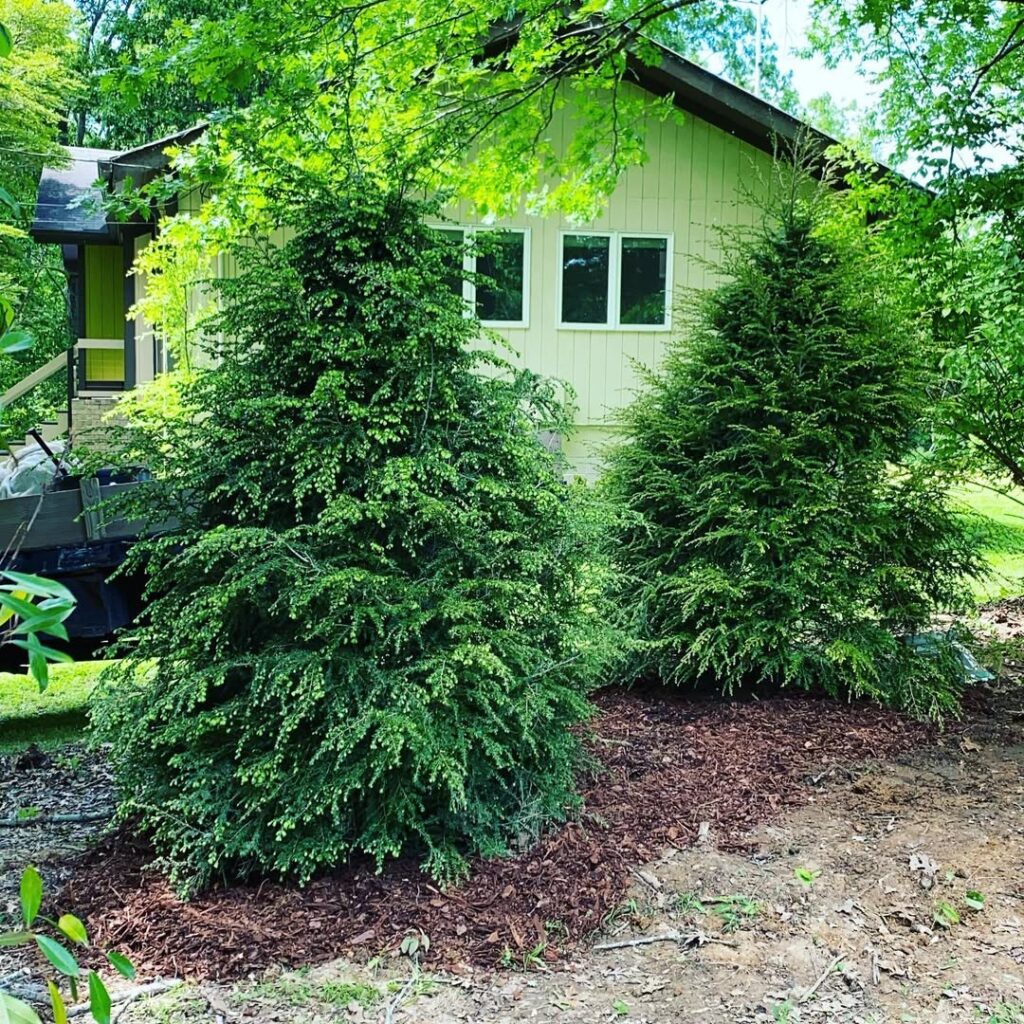
Eastern hemlock (Tsuga canadensis) stands as a keystone species in West Virginia’s mountain forests, creating distinctive ecological communities through its unique environmental modifications. This slow-growing, long-lived evergreen provides year-round shade and forms mixed forests alongside hardwood species, particularly in the Allegheny and Cumberland Mountains.
Unfortunately, eastern hemlock faces severe threats from the invasive hemlock woolly adelgid, which has killed many trees throughout eastern West Virginia since its first detection in 2000. Conservation efforts including insecticide treatments and biological controls are ongoing to protect this ecologically essential species. The tree’s pyramid-shaped form with pendulous limbs and feathery branches makes it an instantly recognizable component of mountain forest ecosystems.
- Hardiness: Cold hardy, well-suited to West Virginia mountain conditions
- Light: Shade tolerant, thrives in understory conditions unlike many trees
- Water: Requires consistent moisture with good drainage
- Soil: Prefers well-draining soils, accumulates organic matter beneath canopy
- Fertilizer: Low nutrient requirements, adapted to forest conditions
- Pest/Disease Resistance: Highly susceptible to hemlock woolly adelgid
- Growth Rate: Slow-growing, occasionally fast but typically gradual development
Sugar Maple
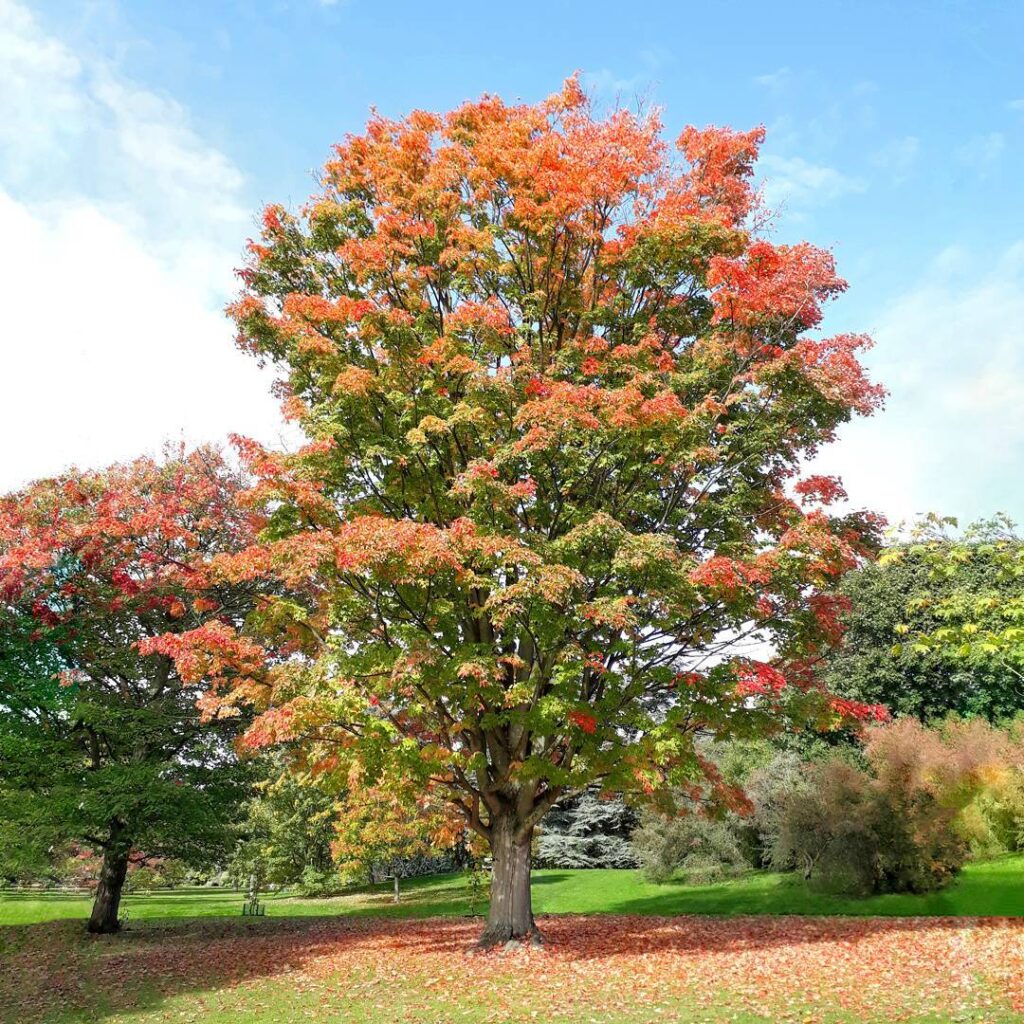
The Sugar Maple stands as West Virginia’s official state tree, thriving throughout all 55 counties with particular abundance in the Appalachian mountains. This magnificent canopy tree typically reaches 70-100 feet in height with trunk diameters of 20-36 inches, serving as a cornerstone species in the state’s mixed hardwood forests.
Beyond its ecological importance, the Sugar Maple offers exceptional value through its brilliant fall foliage, maple syrup production capabilities, and high-quality timber. Its shade tolerance during the seedling stage allows it to regenerate naturally under forest canopies, while its preference for rich, well-drained soils and cool, moist climates makes it ideally suited to West Virginia’s mountainous terrain. The tree’s smooth bark gradually transforms into a distinctive shaggy texture as it matures with age.
- Hardiness: USDA zones 3-8, tolerates January temperatures from -18°C to 10°C
- Light: Full sun to partial shade; shade-tolerant when young
- Water: Moist but well-drained conditions; avoid waterlogged soils
- Soil: Rich, well-drained soil with abundant organic matter; prefers limestone soils; tolerates moderately acidic to slightly alkaline pH
- Fertilizer: Minimal requirements in natural forest settings with rich organic soil
- Pest/Disease Resistance: Generally good resistance but susceptible to salt damage, excessive heat, and leaf scorch
- Growth Rate: Moderate to slow growth rate typical of long-lived canopy trees
American Chestnut

The American chestnut was once the dominant canopy tree across West Virginia’s mountainous landscape, comprising nearly one-fourth of all forest trees before 1920. This majestic species provided essential ecological services, supporting wildlife with abundant nuts and stabilizing soils across Appalachian hillsides.
Tragically, chestnut blight devastated the population by 1929, fundamentally altering West Virginia’s forest ecosystems. Today, restoration efforts led by The American Chestnut Foundation and local partners work to reestablish this keystone species through breeding programs and plantings across 68 sites in 26 counties. These efforts focus on developing blight-resistant varieties while preserving the species’ valuable genetic heritage. Modern cultivation programs emphasize grafting techniques to enhance genetic diversity and improve tree resilience against environmental challenges.
- Hardiness: Zones 4-8, well-adapted to Appalachian mountain conditions
- Light: Full sun to partial shade; thrives in open canopy positions
- Water: Moderate water needs; drought tolerant once established
- Soil: Well-drained, slightly acidic soils; adaptable to various soil types except heavy clay or waterlogged conditions
- Fertilizer: Low fertility requirements; benefits from organic matter incorporation
- Pest/Disease Resistance: Historically susceptible to chestnut blight; modern restoration focuses on blight-resistant varieties
- Growth Rate: Fast-growing when healthy; can reach 2-3 feet per year in ideal conditions
Tulip Tree
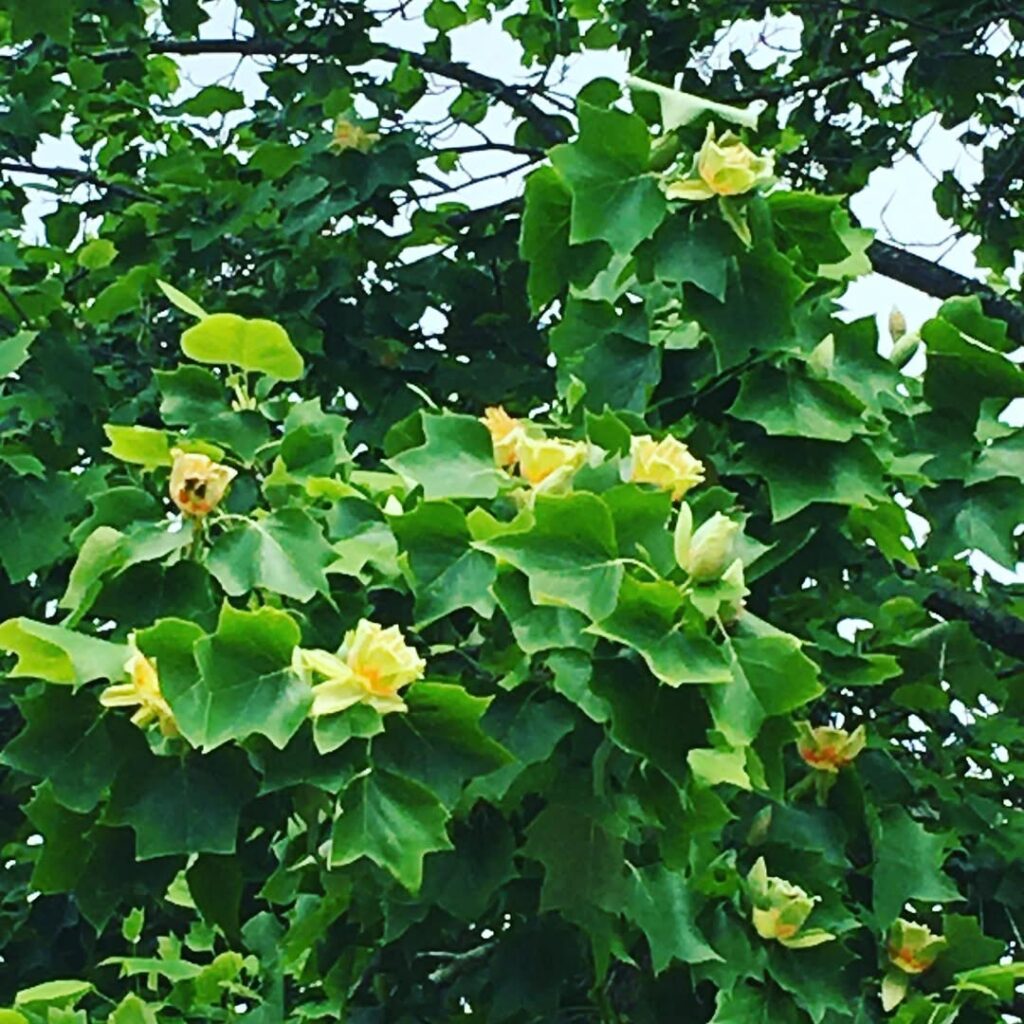
The Tulip Tree is one of West Virginia’s most magnificent native canopy species, thriving particularly in forest coves and lower mountain slopes throughout the state. This fast-growing hardwood can reach exceptional heights over 170 feet in ideal Southern Appalachian conditions, making it among the tallest eastern North American trees. Its straight trunk and notable diameter produce high-quality timber highly valued for lumber and veneer.
As a crucial component of temperate deciduous forests, Tulip Trees form dominant stands alongside oak, pine, and hemlock species. The tree’s large, showy yellow-green-brown spring blooms attract numerous pollinators and contribute considerably to forest biodiversity while providing essential habitat for birds and other wildlife. The distinctive star-shaped foliage transforms into brilliant gold displays during autumn, creating spectacular seasonal color in the mountain landscape.
- Hardiness: USDA Zones 4-9
- Light: Full sun to partial shade
- Water: Moist, well-drained conditions; some drought tolerance once established
- Soil: Rich, well-drained soils; prefers deep, fertile mountain soils and protected coves
- Fertilizer: Minimal requirements in native rich woodland soils
- Pest/Disease Resistance: Generally good; some ecotypes show enhanced resistance to pests and environmental stresses
- Growth Rate: Fast-growing, reaching maturity rapidly compared to other hardwoods
Native Understory Shrub Options
West Virginia’s diverse native understory shrubs offer exceptional wildlife value, seasonal beauty, and specialized adaptations for mountainous terrain, from common species to rare endemics. These plants create distinct vertical layers that provide unique habitats and enhance the overall biodiversity of forest ecosystems.
Mountain Laurel

Mountain Laurel (Kalmia latifolia) is a thick, coarse evergreen shrub from the Heath family that reaches 6-9 feet tall and often forms dense thickets. This native West Virginia plant features leathery evergreen leaves and distinctive pink to white cup-shaped flowers with purple spots that bloom from May to July. Its gnarled stems and peeling bark add winter interest, making it an excellent deer-resistant alternative to non-native boxwoods for foundation plantings, borders, and naturalized areas. The plant’s unique flower structure includes ten stamens positioned in individual pockets within the five-sided corollas, creating an intricate pollination mechanism.
- Hardiness: Native throughout eastern United States, thriving in West Virginia’s mountainous regions
- Light: Part sun to shade, performs well as understory shrub; avoid full direct sun exposure
- Water: Dry to moist conditions, adaptable to various moisture levels
- Soil: Acidic, rocky or gravelly soil preferred; thrives in mesic to dry acidic forests
- Fertilizer: Low maintenance, typically requires no supplemental fertilization
- Pest/Disease Resistance: Deer resistant due to toxic leaves; may develop leaf-spot disease
- Growth Rate: Moderate, forming dense thickets over time in natural settings
Spicebush
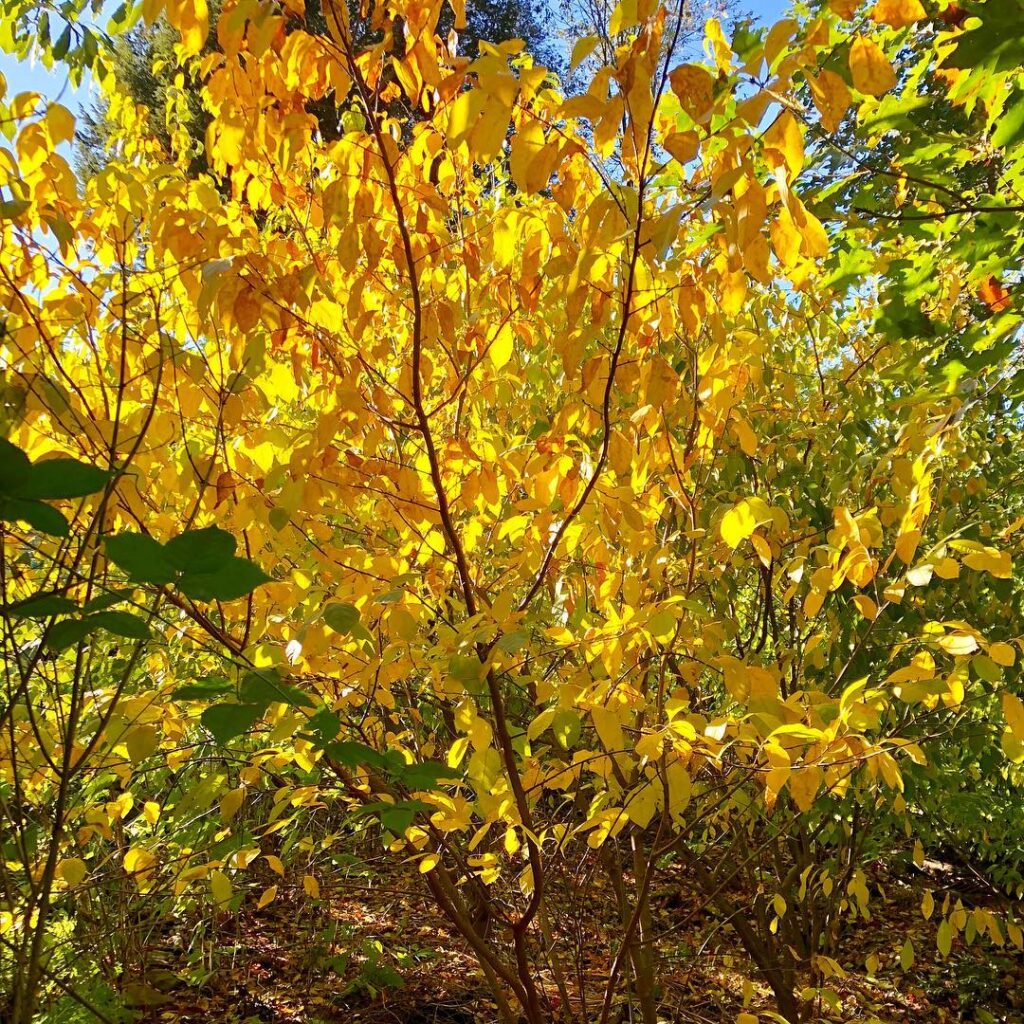
Spicebush is a graceful, multi-stemmed deciduous shrub native to West Virginia’s moist woodlands. Growing 3-15 feet tall, it produces clusters of small yellow flowers in early spring before the leaves emerge, followed by bright red berries on female plants in fall. The oval-shaped leaves emit a pleasant, spicy fragrance when crushed and turn golden in autumn.
This versatile understory shrub provides exceptional wildlife value, serving as a host plant for spicebush swallowtail butterflies while offering early nectar for pollinators and nutritious berries for birds. The ground fruits can be used as a substitute for allspice in culinary applications. Its tolerance for various light and moisture conditions makes it ideal for woodland gardens, rain gardens, and naturalized areas where low-maintenance native plants are desired.
- Hardiness: Zones 4-9, native to eastern North America
- Light: Full sun to full shade; partial sun improves berry production
- Water: Moderate to high moisture; tolerates dry to wet conditions
- Soil: Well-drained sandy loam to medium loam; tolerates alkaline soils
- Fertilizer: None required; thrives in natural soil conditions
- Pest/Disease Resistance: Excellent; no serious issues reported
- Growth Rate: Fast-growing, effective for quick establishment
Downy Serviceberry
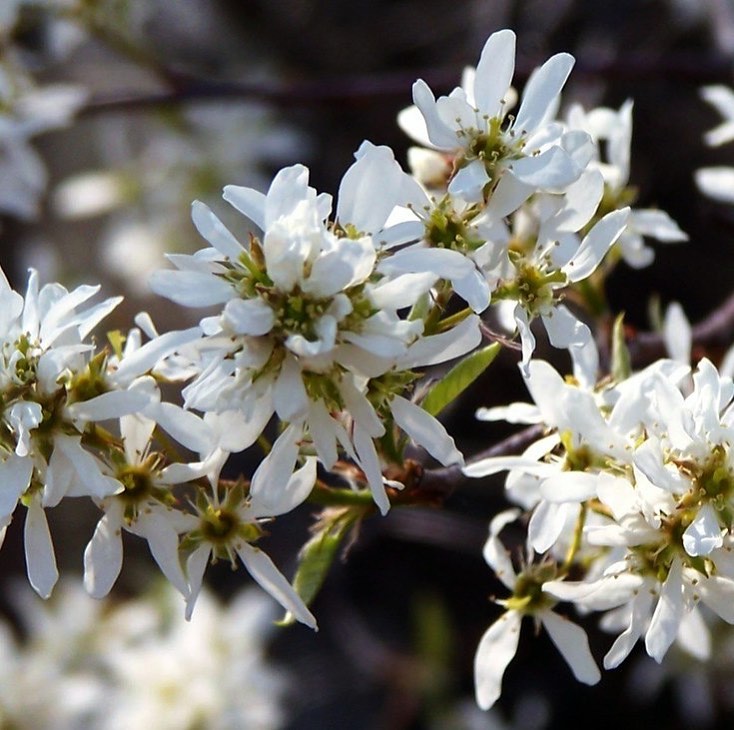
Downy Serviceberry is an excellent native understory shrub that offers exceptional four-season appeal in West Virginia landscapes. This adaptable deciduous shrub reaches 25-35 feet in height and features distinctive slate-gray bark with white streaking. In early spring, clusters of delicate white flowers appear before the leaves emerge, coinciding with shad runs in local streams. The sweet, edible berries ripen from red to deep purple in summer, while the blue-green foliage transforms to brilliant orange-red in fall.
As an early-successional species, serviceberry naturally colonizes disturbed areas and thrives in various growing conditions. It provides valuable wildlife habitat, supporting pollinators with spring nectar, feeding songbirds with summer berries, and serving as a host plant for several butterfly species including Viceroy and Eastern Tiger Swallowtail. West Virginia is home to five species of serviceberry, including both shrub and small tree forms that commonly grow in fence-rows, thickets, and rocky outcrops throughout the region.
- Hardiness: Zones 4-9
- Light: Full sun to full shade
- Water: Moderate; prefers moist, well-drained conditions but moderately drought tolerant
- Soil: Acidic, well-drained soils preferred; adapts to various soil types; moderately salt tolerant
- Fertilizer: Low requirements; benefits from mycorrhizal associations
- Pest/Disease Resistance: May experience cosmetic issues but rarely life-threatening problems
- Growth Rate: Fast-growing
Redbud
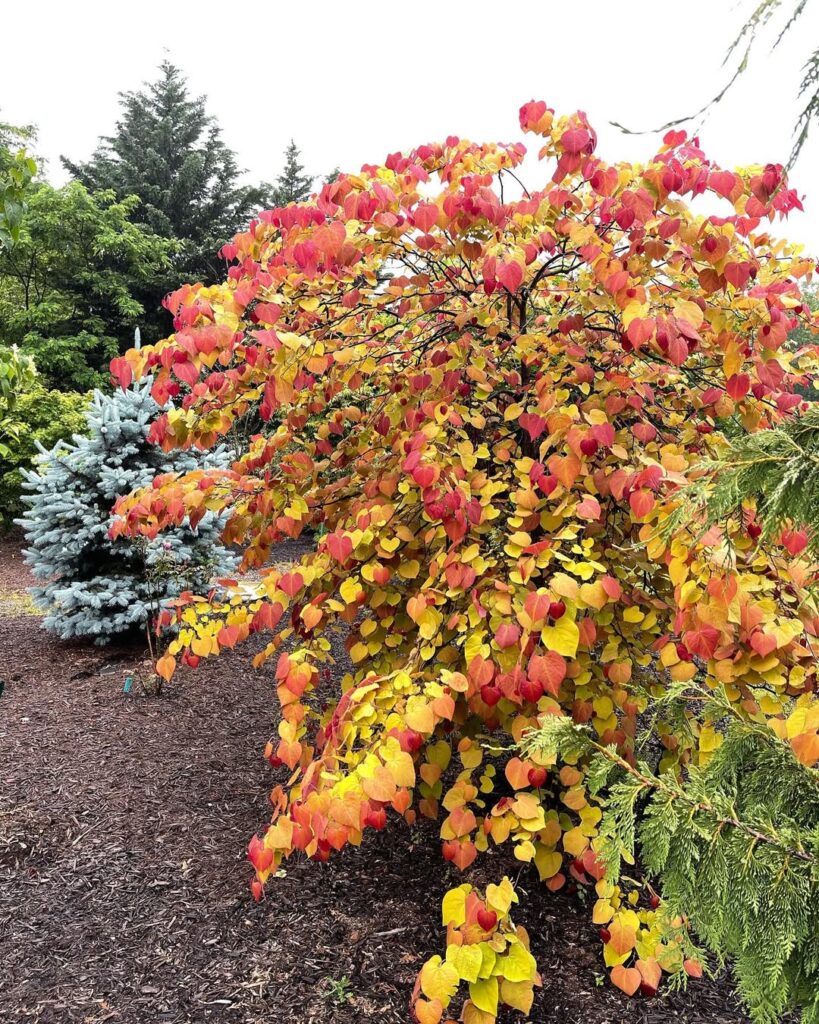
Redbud is a beloved native understory tree that serves as one of West Virginia’s most recognizable spring bloomers. This adaptable species produces stunning rosy-pink flowers directly on its trunk and branches in early April, creating a spectacular display before the heart-shaped leaves emerge. Growing 25-50 feet tall with a broad, graceful crown, redbud thrives throughout the state’s diverse landscapes from moist woodlands to drier fields. Its early blooms provide essential nectar for emerging pollinators, while its tolerance for various soil conditions and rapid growth make it an excellent choice for native landscaping. The tree supports local wildlife by hosting butterfly caterpillars that serve as crucial food sources for songbirds.
- Hardiness: USDA zones 4-9, cold hardy throughout West Virginia
- Light: Full sun to partial shade; more sun produces more abundant flowering
- Water: Moderate to consistent moisture; not drought-tolerant, prefers well-drained but moist conditions
- Soil: Adaptable to various soil types; prefers fertile, well-drained soils with pH 6.0-8.0; tolerates both calcareous and acidic soils
- Fertilizer: Low maintenance; benefits from organic matter but rarely needs supplemental feeding in good soil
- Pest/Disease Resistance: Moderate; susceptible to canker diseases in poorly drained soils and root stress conditions
- Growth Rate: Fast-growing when young, establishing quickly in suitable conditions
Elderberry
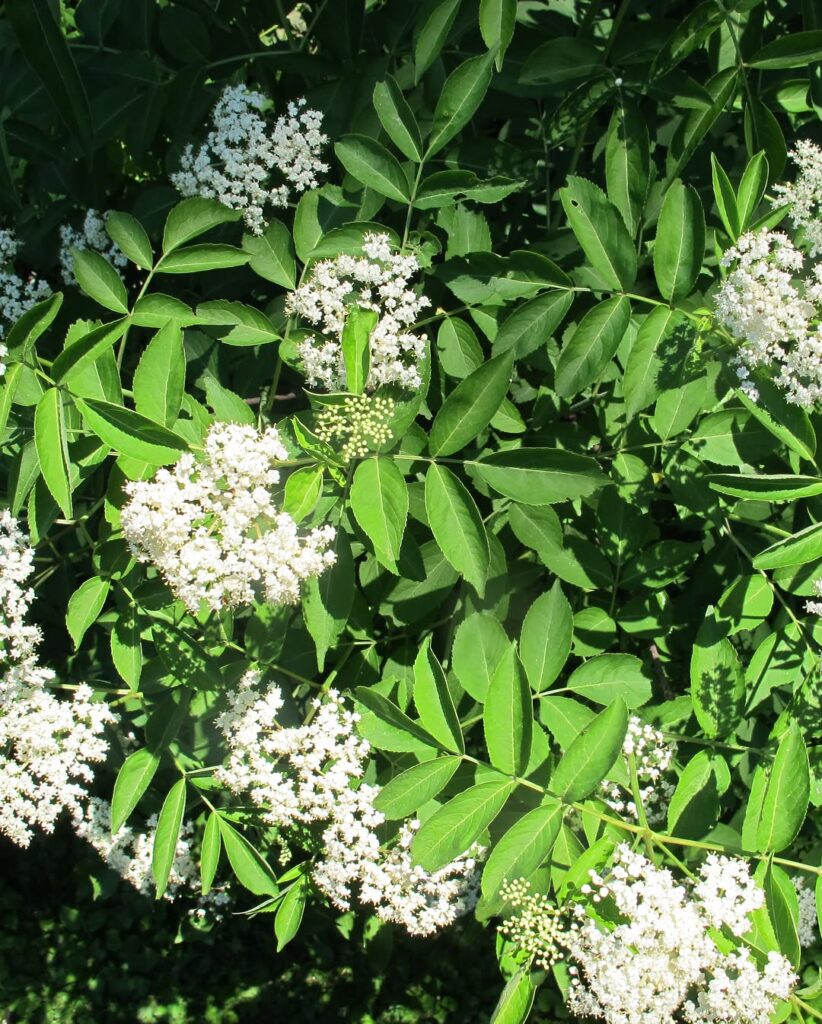
Elderberry offers West Virginia gardeners excellent native shrub options, with black elderberry (Sambucus canadensis) thriving throughout all counties and red elderberry (S. pubens) concentrated in mountain regions. These multi-stemmed deciduous shrubs reach up to 12 feet tall, forming dense thickets through vigorous root suckering. They produce showy flat-topped clusters of fragrant white flowers from May to July, followed by dark berries that provide vital wildlife food for over 43 bird species.
Black elderberry adapts to various disturbed sites including roadsides and reclaimed strip-mines, while red elderberry prefers rocky mountain woods at higher elevations. Both species require periodic heavy pruning to control aggressive spread but offer exceptional ecological value as pollinator plants and wildlife food sources. The edible black elderberries (when cooked) add practical value for jellies and syrups. As one of the first shrubs to leaf out in spring, elderberry provides early season structure and interest to native plant landscapes.
- Hardiness: Native to eastern U.S., cold hardy throughout West Virginia
- Light: Full sun to partial shade; best flowering in full sun
- Water: Moist conditions preferred; tolerates wet areas and swamps
- Soil: Rich, moist, organic soils ideal; slightly acidic to neutral pH; tolerates various soil types
- Fertilizer: Low maintenance; thrives in naturally rich soils
- Pest/Disease Resistance: Generally free of major insect and disease issues; moderately deer resistant
- Growth Rate: Fast growing; spreads vigorously by root suckers
Selecting the Right Native Plants for Your Garden
Three key factors determine your success when choosing native plants for your West Virginia garden: soil conditions, available space, and your specific goals. Start with soil testing to understand your pH levels and clay content. This guides plant selection toward species that’ll actually thrive in your conditions.
Consider mature sizes carefully. Switchgrass reaches 7 feet, while Little Bluestem stays compact. Big difference in small spaces. Match plants to your garden’s purpose too. Want pollinators? Choose Wild Bergamot or Red Cardinal Flower. Need winter interest? Winterberry’s your answer. Smart planning prevents costly mistakes and reduces future maintenance requirements.
West Virginia’s diverse landscape spans three distinct ecoregions, each supporting different native plant communities that influence what will succeed in your specific location.
Frequently Asked Questions
How Do I Propagate Native Mountain Plants From Seeds or Cuttings?
Though propagation seems complex, you’ll succeed with proper timing. Collect seeds in late fall, then cold-stratify them for 60-120 days. Use cutting techniques on softwood stems, applying rooting hormone for better results.
What Native Plants Attract Hummingbirds and Butterflies to Mountain Gardens?
You’ll attract both species with Cardinal Flower, Bee Balm, and Butterfly Milkweed in your garden. These natives outperform hummingbird feeders while creating stunning butterfly gardens that support local ecosystems better than non-native alternatives.
Which Mountain Natives Are Deer Resistant and Won’t Be Eaten?
You’ll find deer resistant native plants include aromatic species like yarrow, lavender hyssop, and mint family members. Spiny American holly, toxic monkshood, and tough-leafed iris also deter browsing effectively in mountain gardens.
How Often Should I Water Newly Planted Native Mountain Species?
You should water newly planted natives twice weekly for two weeks, then once weekly through the first season. Monitor soil moisture regularly and adjust watering frequency based on rainfall and your specific mountain soil conditions.
What’s the Best Time of Year to Transplant Established Native Plants?
Like tucking plants into bed for winter, you’ll achieve ideal transplanting timing during fall’s mid-September through October window. This dormant period prioritizes plant health by reducing stress and encouraging strong root establishment before spring’s awakening.
